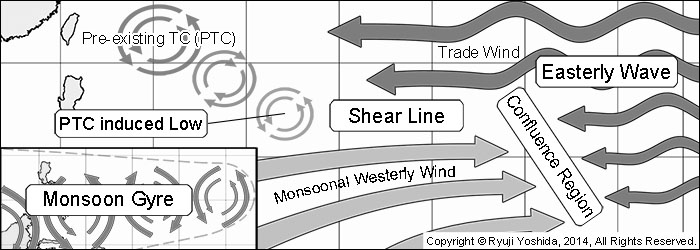Welcome to Ryuji's page

The flow environment associated with tropical cyclone genesis (TCG) over the western North Pacific was assessed via categorization into five flow patterns: monsoon shear line (SL), monsoon confluence region (CR), monsoon gyre (GY), easterly wave (EW), and preexisting tropical cyclone (PTC). Using reanalysis data and an objective algorithm, the authors defined ‘‘contribution scores’’ for the five flow patterns. Each score represents the contribution to TCG from each flow pattern, and scores were calculated for 908 TCG cases from 1979 to 2008 (30 yr). Of the major contribution flow patterns, SL accounted for 42% of TCGs, EW for 18%,CRfor 16%, PTC for 11%, andGYfor 6%. Seasonal variations in the occurrence frequency of these five patterns were clear, but interannual variations were not as apparent. Tropical cyclones often appear to be generated in conditions with multiple flow patterns. Thus, relationships between multiple flow patterns were investigated by comparing contribution scores. The SL and CR patterns were strongly correlated to each other, which can be explained by the monsoon southwesterly that organizes both patterns. The EW pattern tends to be independent of the other flow patterns. The PTC pattern has a relatively high correlation with CR, but does not have a correlation with SL or EW. Thus, the characteristics of flow patterns for the occurrence frequency of TCG are derived for a longer period than in previous studies, and correlations among flow patterns are also investigated.
Result ofcategorization by the objective analysis are shown below, and PLEASE REFER Yoshida and Ishikawa (2013, MWR), WHEN YOU USE THIS RESULT in your research. For details, see Yoshida and Ishikawa (2013, MWR).
Yoshida R. and H. Ishikawa, 2013: Environmental Factors Contributing to Tropical Cyclone Genesis over the Western North Pacific. Mon. Wea. Rev., 141, 451-467.